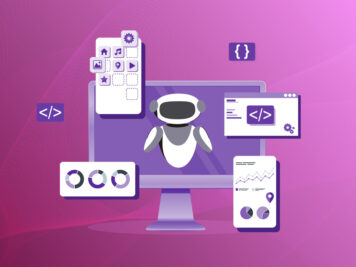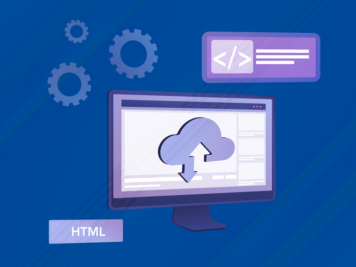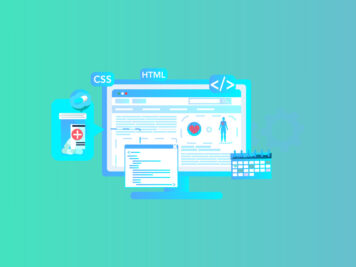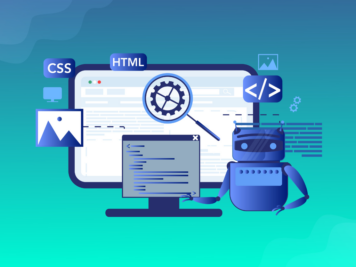Key Takeaways
- Investing in custom software development is crucial for businesses looking to stay competitive, as it enables them to meet evolving customer demands, adapt to emerging technologies, and future-proof their operations.
- Custom software outperforms off-the-shelf solutions in terms of scalability, return on investment (ROI), seamless integration, enhanced security, productivity gains, and full ownership, offering a long-term strategic advantage.
- Clear product goals and user insights are essential for creating a well-defined development roadmap that aligns with business objectives and delivers maximum impact.
- Business owners must be mindful of challenges such as high initial investment, tight deadlines, scope creep, and ongoing maintenance, ensuring they are factored into planning and decision-making.
- Choosing the right tech team is the key. They must align closely with the product vision to ensure successful outcomes. They should possess the necessary technical expertise and experience to drive development while staying focused on the end goal.
All an entrepreneur wants is to build a product its users love. The question is how to build one. This leads to a rigorous study of the users to groom their stories and identify the features they want the most. But developing them by following standard practices is not always a viable option. Those pressing times require custom software development.
Startups and enterprises, after overcoming customer acquisition hurdles, now view custom software development as essential to driving business success. This fuels the global custom software development market’s growth. Its valuation has already crossed the $35 billion mark in 2023, and the CAGR is expected to hit 22.5% from 2024 to 2030. But does all this mean that custom software development can guarantee success?
The answer is “NO.” The success of custom software depends on various factors: clear requirements, stakeholder involvement, tech stack, project management, QA, UX/UI, scalability, security, compliance, integration, post-launch support, and ROI. These factors also change with the product stage. For example, big tech companies typically train models using their own data. In contrast, startups often begin without a large data repository to customize models.
In the last 21 years, we have built over 200 products for companies across stages. These products involved AI, blockchain, GenAI, DevOps, Open Source, IoT, AR/VR, and other technologies. We have learned that successful custom software development hinges on a step-by-step approach, where groundwork is just as crucial as the development itself. But before starting with the development process, let’s do a quick tour of what it is, why invest in it, and how it differs from off-the-shelf software.
What is custom software development?
Custom software development is the process of designing, creating, deploying, and maintaining software solutions tailored specifically to the needs, requirements, and goals of an individual business or organization.
Custom development often involves close collaboration between the development team and the organization to ensure the software aligns with the business’s objectives and delivers the desired functionality, user experience, and scalability. Custom software can range from web and mobile applications to enterprise-level systems and is commonly used when standard solutions are insufficient or need significant customization to fit the business model.
Why invest in custom software development?
Custom software ensures the technology evolves with the business, providing flexibility, security, and a competitive edge. Timely investment in such a developmental process can reduce the chances of piling up tech debts and loss of work hours. There are 3 major areas where it can have a significant impact.
The evolving technology landscape
As businesses evolve, so do their requirements. Startups often work with emerging technologies that rapidly change before stabilizing, while mature companies adopt the latest advancements to remain competitive and open new revenue streams. In both cases, a flexible software architecture that supports seamless integration of new features is essential. However, off-the-shelf software often falls short, as its pre-built frameworks aren’t always aligned with cutting-edge technologies.
Meeting customer expectations
A product’s success often hinges on intuitive design. Spotify, with nearly 300 million users, outpaces Apple Music largely due to its social features. By understanding user needs and seamlessly integrating new features, Spotify created a user experience that sets it apart as a market leader.
Equally crucial is security, especially in industries like healthcare and fintech, where customer trust is paramount. A single data breach in these sectors can result in millions of dollars in losses and a significant erosion of customer confidence.
Future-proofing your business
Custom software, when designed correctly, can be easily adapted and scaled to meet new demands. The impact of COVID-19 highlighted this more than ever. The rapid shift in consumer behavior disrupted supply and demand, catching many companies off guard. Businesses that couldn’t adapt quickly faded, while those with flexible, scalable solutions thrived and grew rapidly.
The initial investment may be higher for custom software development. But it eliminates recurring licensing fees, reduces reliance on third-party vendors, and can result in significant savings over time.
Custom software development vs. off-the-shelf software
Custom software development and off-the-shelf software both offer some distinct advantages and limitations. Recognizing the key differences is essential to determine which option aligns best with the business needs, future growth, and budget.
We have compared both based on four major parameters: specific to business needs, integration, ROI, and scalability.
Specific to business needs
Custom software is specifically designed to meet unique business needs, offering tailored features and functionalities that align with specific processes and objectives. It seamlessly integrates with workflows, delivering solutions that match business goals while providing greater flexibility, efficiency, and long-term value. In contrast, off-the-shelf software often serves as a quick fix but rarely addresses the unique challenges businesses face, limiting its long-term effectiveness.
Integration
Integrating custom software with existing systems is relatively seamless, ensuring smooth data flow with minimal disruptions. It can be tailored to fit the current infrastructure, making the integration process more efficient and reliable. On the other hand, off-the-shelf software often comes with limitations and may not integrate with existing systems as desired, requiring additional workarounds or third-party solutions to function properly.
Return on investment
Off-the-shelf software is generally more cost-effective upfront compared to custom solutions, but it often follows a subscription-based model, where costs can steadily increase as the business grows. Custom software, on the other hand, comes with a higher initial development cost, which can make it less appealing to early-stage startups. However, for larger tech companies, custom software offers a compelling ROI advantage, as it avoids the ongoing incremental expenses of subscription fees, making it a more cost-efficient solution in the long term.
Scalability
Custom software is built to scale with the business. It allows seamless updates and the addition of new features as needs evolve, ensuring that the product continues to align with business goals and growth. In contrast, off-the-shelf software offers limited scalability. It makes customers dependent on the vendor’s updates. These updates may not align with the business’s pace or specific needs and affect long-term growth and efficiency.
Benefits of Custom Software Development
Custom software development also has some secondary but impactful benefits. For instance, easy scalability and flexibility improve productivity and efficiency. Similarly, customization ensures the product has higher security and data protection, as well as more ownership and control.
Improved productivity and efficiency
Custom software provides tailored solutions and improved productivity. We worked with a conversational AI platform that wanted to increase customer engagement by sorting relevant comments and addressing them. Our customized software not only helped them increase engagement, it opened new revenue streams for them. Custom software integrates seamlessly with existing systems. It reduces manual work and errors and can scale as the business grows. This flexibility ensures long-term efficiency and adaptability, resulting in improved operations and higher productivity compared to generic solutions.
Higher security and data protection
Compliance needs and risks differ from business to business. Custom software solutions are better equipped to address these issues as they come with tailored security features, such as advanced encryption, multi-factor authentication, and secure access controls. Such software can also be regularly updated to patch vulnerabilities and adapt to emerging security threats, ensuring that sensitive data is better protected. Its integration with a company’s existing security infrastructure is tighter than that of off-the-shelf software, and it minimizes potential gaps.
Ownership and control
As the company owns the software, it can dictate how features are developed, integrated, and updated, without relying on third-party vendors or being constrained by their roadmaps. This autonomy enables the business to implement tailored features, maintain data privacy, and adapt the software as their needs evolve.
Cost efficiency
To ensure scalability, ease of integration, and flexibility, engineers meticulously focus on grooming the user story and reviewing all potential corner cases at the outset of custom software development. By doing this, they minimize the likelihood of unexpected changes in the development roadmap or surprises that could result in platform migration or major modifications down the line to accommodate emerging technologies. This proactive approach helps in building a future-proof system, designed to evolve with the business and adapt seamlessly to new trends, while also preventing costly overhauls.
Critical Steps Before Starting Custom Software Development
Just because a lot of companies are adopting custom software development doesn’t mean that it is good for all. If it is in the plan, then its launch requires some groundwork. The task involves the following steps:
Assess current solutions
Understanding your business needs is key to any software development. First, get a clear picture of your business requirements and check if your current product aligns with them. Next, identify any gaps in off-the-shelf solutions that could slow your progress. While custom software is tempting, off-the-shelf options are often more affordable, especially for early-stage startups facing budget constraints. For them, the cheaper alternative might be the smarter choice.
Cost-benefit analysis
Compare the costs of developing a custom solution and modifying the existing one. This review should include factors like long-term benefits, such as scalability, tailored features, and upfront costs. Many companies, in their attempts to develop a bespoke solution, often end up piling tech debt.
Scalability & flexibility
As your product evolves, so do its milestones and requirements. Early on, the focus is on finding product-market fit. Once achieved, the priority shifts to quickly acquiring paying customers and scaling the user base. This demands a scalability check of your product. It should also be flexible enough to adapt to unplanned needs and pivot for new business opportunities.
Integration requirements
If you decide to proceed with custom development, you should also plan for the integration of the new software. You must check whether you need a third-party application or if your existing system is good enough. The new software should primarily connect well with databases, CRM systems, payment gateways, or other software tools that your business uses. Difficulties in integration could lead to inefficiencies, increased costs, or even disruptions in your business processes.
User experience
What are the reactions of your users? How do they feel about your product? Answers to these are important to decide the roadmap. If they are affirmative, then customizing the software will only affect their experience as there will be some downtime for changes. The beta phase for a new product is also important when deciding on customization.
Security & compliance
This is becoming a significant concern for big tech, especially with the rise of GenAI tools. GenAI relies on data for training, making it vulnerable to breaches. To mitigate this risk, many big tech companies are now using their own models on their platforms. As a product owner, it’s crucial to assess your data’s sensitivity and ensure your custom solution aligns with compliance standards.
Stakeholder input
Alignment between the tech team and product vision is crucial as it reduces iterations. It helps meet deadlines, mitigate costs, optimize resources, and deliver outcomes. Stakeholders provide valuable input to clarify requirements, prioritize features effectively, and enhance user experience, and these are indispensable for informed decision-making and strategies. Their continuous feedback also fosters a healthy work environment for a successful product.
Stages of custom software development process
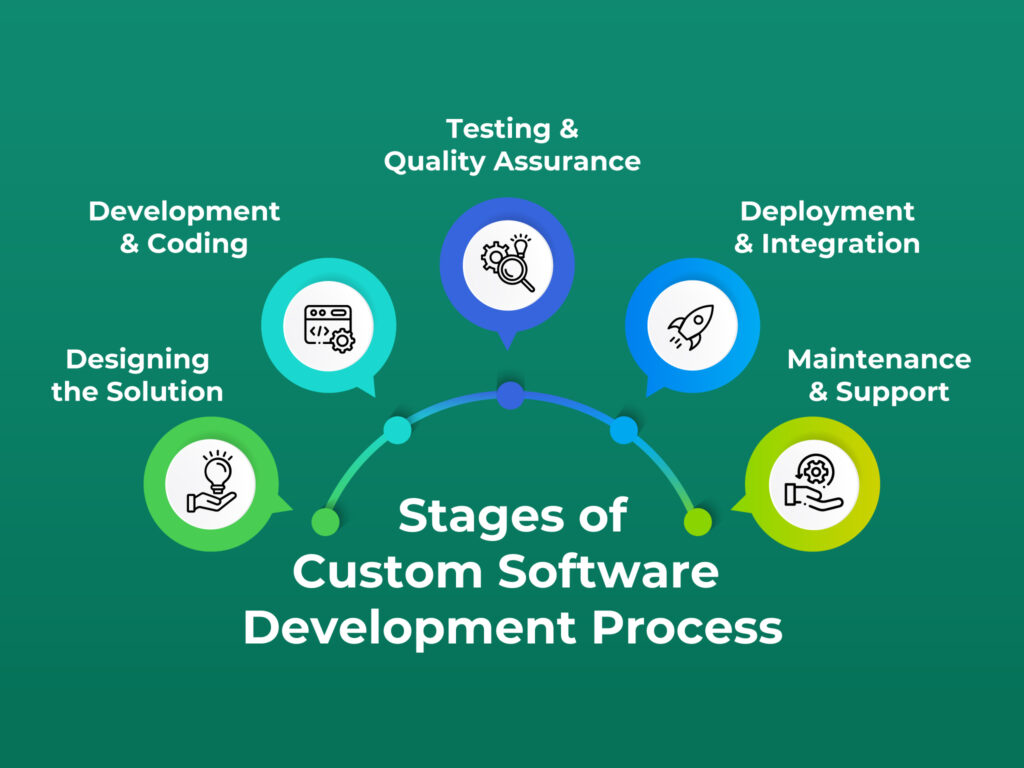
Once the groundwork for planning, feasibility checks, and goal alignments is done, engineers must follow the following five steps to make the actual development more effective.
Designing the solution
The design phase is crucial in translating the business requirements and technical specifications into a concrete framework for the software. It requires a detailed blueprint to underline how the system will function, both from a technical perspective and from the user’s point of view.
System Architecture Design:
The architecture design defines how the various components of the software, such as databases, servers, and applications, will interact with each other. It involves crucial decisions like choosing one from on-cloud and on-premise solutions or microservices and monolithic architecture. Engineers must ensure their technologies, programming languages, frameworks, and tools are aligned with the product vision as this step sets the foundation for performance, security, and scale. A misalignment could trigger tech debt, resulting in the loss of valuable resources.
Database Design:
The database structure is defined, including how data will be stored, accessed, and managed. Data models are created to outline the relationships between different data entities. This step ensures that the system can efficiently handle large volumes of data and that it meets any specific data management or compliance requirements.
UX & UI Design:
Engineers must groom the user story first before starting with the UX design as on it depends how intuitive and easy to use the software will be. User workflows are mapped out to ensure the software supports how users will interact with it and users can achieve their goals with minimal friction.
The UI design involves creating the visual elements of the software—such as screens, buttons, and menus—to align with the brand’s identity and create visually appealing designs. Stakeholders should get mockups, wireframes, or prototypes to understand what the final product will look like. It will reduce future iterations. The same can be used to gather early feedback from users before moving into development.
Technical Documentation:
The team should create technical documentation, including design documents, system flow diagrams, and interface specifications, to guide development. This roadmap ensures efficient software implementation and helps new recruits quickly understand the product, allowing them to get involved without delay.
This phase helps mitigate risks by identifying potential challenges early and provides a strong foundation for the development phase.
Development and coding
In this phase, the software is built based on the design specifications. Developers break the software into smaller modules, allowing parallel development for easier management. They write the code using chosen languages and frameworks, adhering to coding standards and best practices. Version control systems like Git ensure collaboration and track code revisions, while continuous integration (CI) helps catch issues early by running automated tests with each code integration.
From our experience developing over 200 products, I can say that the design handover to developers is crucial here. Design specifications have to be very clear, or else they could lead to unwanted iterations and deadline failures.
During this phase, backend and frontend development are often done in parallel. Backend developers handle server-side logic, databases, and APIs, while frontend developers create the user interface and ensure smooth interaction with the backend. Many teams follow an iterative or Agile approach, delivering features in short cycles (sprints), which allows for continuous feedback and adjustments to align the product with user and business needs.
Unit testing is performed throughout development to ensure individual components function as intended. This happens seamlessly when team members collaborate continuously using tools like Slack and Jira to communicate, track progress, and manage tasks efficiently.
Testing and quality assurance
Testing and quality assurance are to ensure that the product meets the required standards and functions. The phase begins with unit testing, where developers test individual components or modules of the software to verify that each part works correctly in isolation.
Once these components are integrated, developers move on to functional testing to ensure that the entire system operates seamlessly, with all features interacting correctly. Test cases are meticulously crafted based on the design specifications, covering a wide range of scenarios, including edge cases, to verify that the software behaves as expected under various conditions.
With GenAI now in the mix, this stage is undergoing a major transformation. Developers can rapidly generate diverse testing scenarios using AI, allowing them to test the software more thoroughly and efficiently, ultimately enhancing the product’s efficacy and reliability.
There are other testing methods as well beyond the functional testing. Performance testing checks how well the system handles large workloads. Stress testing pushes the system to its limits under extreme conditions. Security testing looks for vulnerabilities. User acceptance testing (UAT) evaluates the software from the end-user’s perspective to ensure it meets their needs and business goals.
Bugs and issues are directly sent to the development team for fixing. This testing, feedback, and fixing cycle should continue until the software is stable, reliable, and ready for deployment.
Deployment and Integration
In this stage, developers move the software from a development or testing environment to a live production environment. They install it on servers or platforms where users can access it. Automation has made the process faster and more accurate and reduced the chances of errors.
To address any final issues, the product must be rolled out softly or piloted with a limited group of users.
Deployment is crucial as many products fizzle out before reaching this stage. In the case of machine learning, the number is around 85%.
Software integration has to be seamless with existing systems, tools, or databases. It should work well with the organization’s current infrastructure. The process may also require data migration. Developers should work on how data flows between systems as well to ensure no disruptions occur.
Our experience tells us that there should be another round of testing in the live environment after this to confirm the software is ready for full use.
Maintenance and support
The custom software development process doesn’t stop at deployment and integration. It requires further involvement for maintenance and support. Regular updates will be provided based on user requirements. Fixing bugs, improving performance, and ensuring compatibility with new technologies or changes in the business environment will also require careful planning.
Customizing is good, but over-customization can kill the product. Developers must assess if customer-specific features benefit the broader user base. Irrelevant features can turn into tech debt and create future problems. Striking the right balance ensures long-term product success.
Support, on the other hand, involves assisting users with any issues they encounter while using the software. This could range from troubleshooting technical problems to offering guidance on new features. A dedicated support team is usually available to resolve these issues quickly, minimizing disruptions. Continuous support helps ensure user satisfaction and smooth operation, while also gathering valuable feedback that can inform future updates or improvements to the software.
While developing a product to handle 8 billion daily ad requests for an adtech company, we recognized the importance of ROI. Some demands offer no clear short- or long-term impact. Product managers should sideline those requests and focus on what truly matters.
Common challenges in custom software development
Customized software comes with its own set of challenges. These issues should be studied well before launching the custom software development plan.
High initial costs
For early-stage companies, custom software development could be a problem as they lack the funds to develop software. Custom software development requires a significant upfront investment. Costs include gathering requirements, designing, developing, testing, and deploying the software. Moreover, the need for specialized expertise can further drive up expenses.
Big tech companies may not find this cost a challenge as they can commit financially to consider the long-term benefits over the initial costs.
Time to market
Startups racing against tight deadlines or companies eager to launch products ahead of competitors need to weigh this challenge carefully before shaping their product roadmap. Custom software development, while offering tailored solutions, typically takes longer to execute than off-the-shelf alternatives. This time lag can be a major obstacle for businesses aiming to seize market opportunities swiftly. The intricate phases of planning, development, and testing inevitably extend the project timeline. So, if onboarding paying customers is a priority, off-the-shelf solutions may provide the speed and efficiency needed to hit the ground running.
Risk of scope creep
Scope creep occurs when the project’s objectives gradually expand beyond the original plan. This can happen due to changing business requirements, misunderstandings, or evolving technology trends. Scope creep leads to delayed timelines, increased costs, and often a loss of focus on the project’s core objectives. Prioritizing feature shipments aligned with product goals can help businesses in reducing scope creep.
Maintenance and updates
After deployment, custom software requires ongoing maintenance and updates to ensure smooth functioning. This involves fixing bugs, improving performance, and adapting the software to evolving business needs or technological advancements. Unlike off-the-shelf solutions that provide regular updates, custom software relies on in-house or third-party developers to handle these aspects, which can increase costs and resource requirements over time.
Employee adoption and training
Custom software, while designed to meet specific needs, can be unfamiliar to the employees who are supposed to use it. Resistance to change, coupled with a steep learning curve, can hinder employee adoption. This is evident from a recent study conducted by the Adecco Group. The study is about GenAI adoption by the workforce, and it reveals that access to this technology is unequal and threatens to create groups of “haves” and “have-nots” in the workforce. Also, many workers have raised concerns about inadequate training.
Organizations must invest in training and support for customized software to ensure smooth onboarding and maximize the software’s effectiveness.
Right Methodologies for Custom Software Development
The right development methodology directly impacts the software’s speed, quality, and adaptability. Here are four common methodologies used in custom software development:
Basic SDLC
The Software Development Life Cycle (SDLC) is a traditional, structured approach that guides the development process through clearly defined phases—requirement analysis, design, development, testing, deployment, and maintenance. It’s a step-by-step method that ensures thorough planning and organization for projects with clear objectives and minimal changes during development.
Evolutionary prototyping
Evolutionary prototyping focuses on building a working prototype of the software early in the process. It is continuously refined based on user feedback and evolving requirements. This iterative approach allows developers and stakeholders to validate ideas and adjust the design as the project progresses. This methodology is ideal for projects where requirements are not fully understood from the start, as it allows flexibility and adaptability.
Rapid Application Development (RAD)
RAD prioritizes speed by focusing on iterative development and early delivery of functional components. It allows for continuous user feedback and quick adjustments to the software, reducing time to market. RAD is best suited for projects with well-defined business requirements that can benefit from rapid prototyping and modular development. But its success depends on a highly skilled development team and can be resource-intensive.
Agile development
Agile promotes flexibility, collaboration, and iterative progress through short development cycles called “sprints.” Teams work closely with stakeholders throughout the project, continuously refining the software based on feedback and changing requirements. Agile is highly adaptive, making it perfect for complex projects with uncertain or evolving needs. It thrives on constant collaboration and a disciplined team aligned with project goals and deadlines.
How to choose the right custom software development partner
Early-stage startups begin with a small team and often do not have the tech team required to build custom software. This is one of the major reasons why they onboard tech partners. Big tech companies collaborate with tech teams to reduce tech burden and development costs or bridge tech gaps.
The success of these collaborations hinges on choosing the right custom software development partner.
Key factors to consider
There are four crucial factors.
Technical expertise and experience
Collaboration happens either to bridge a tech gap or to address specific technological requirements. That is why the team’s technical expertise, how they upgrade themselves according to the project requirements, what kind of technological support they can provide for unforeseen requirements, and experience in the domain are of the utmost importance.
In recent years, the pandemic and GenAI have swiftly reshaped the tech landscape, forcing many companies to rethink their product roadmaps. However, not all tech teams can adapt quickly. Only experienced, one-stop solution providers can foresee these shifts and add real value to custom software.
Industry knowledge and specialization
Tech support providers must have the right expertise. While developers can pick up some skills as a project progresses, they need a solid foundation in the technology they’re using. Since custom software development varies greatly across industries, developers and project leads must understand the industry’s unique requirements. Without this knowledge, key nuances can be missed, leading to less effective solutions. An informed team can create tailored, efficient software that aligns with industry standards and meets specific needs.
Portfolio and case studies
Before selecting a custom software development partner, decision-makers should thoroughly evaluate the potential partner’s portfolio. This process helps to assess the team’s expertise and experience across relevant projects. By reviewing their past work, decision-makers can gauge the partner’s ability to deliver solutions aligned with the company’s unique needs and industry standards. A strong portfolio demonstrates technical proficiency, innovative thinking, and problem-solving capabilities. It also provides insights into how well the partner has handled similar projects, managed challenges, and delivered successful outcomes.
Client testimonials and reviews
Client reviews provide firsthand insights into the partner’s reliability, communication skills, and ability to meet project goals. Positive testimonials reflect a partner’s ability to deliver on promises, while constructive reviews may highlight areas of improvement or challenges faced during the project. By considering client feedback, decision-makers can better understand the partner’s strengths and weaknesses, as well as their approach to problem-solving and customer satisfaction.
Questions to ask potential partners
There are four questions about which businesses should be absolutely sure:
What is their development process?
When a third party develops a product, having clarity on the development process becomes essential. This is where a detailed breakdown of the process can prove invaluable. It offers crucial insights into how the development team will keep the product owners informed and involved throughout the project. It also sheds light on their ability to meet deadlines, manage tasks efficiently, and handle unforeseen challenges. Clear communication and transparency in the development process help build trust, ensuring that expectations align and the final product meets business goals.
How do they handle project management and communication?
Understanding how a development partner handles project management and communication is crucial for a successful collaboration. Strong project management ensures that timelines are met, resources are allocated effectively, and potential issues are addressed promptly. Equally important is their communication style—regular updates, transparent reporting, and open channels for feedback help keep the project on track and align with the client’s vision. Reduced communication overhead also guarantees more free time for the decision-makers to focus on the business side.
What post-launch support do they offer?
When evaluating a development partner, it’s important to understand the types of support they offer after the product goes live. This can include bug fixes, regular updates, performance monitoring, and security patches. Additionally, good post-launch support may involve scaling the product as user demands grow, offering training for in-house teams, and providing ongoing technical assistance to resolve any issues that arise.
How do they align values and expectations?
When companies work with external development teams, aligning values and expectations is crucial. A shared understanding of work ethic, problem-solving approaches, and long-term goals fosters smoother cooperation and minimizes conflicts. If the development team’s culture mirrors the client’s values—such as innovation, flexibility, or a focus on quality—both parties are more likely to be aligned in their approach to challenges and milestones.
Evaluating proposals and pricing
Avoiding unexpected costs after onboarding a tech partner is vital to ensure the product receives the attention it deserves and prevents future headaches.
How to compare proposals and what to look for
Businesses often onboard third-party tech partners to reduce costs, but choosing the lowest bidder isn’t always the best move. Companies offering the lowest bids often cut corners, compromising on both talent quality and deliverables.
It’s essential to look beyond price and assess the true value each partner offers. Key factors include the scope of work, clarity of deliverables, timelines, talent quality, and innovation focus. A strong proposal should demonstrate how the partner aligns with your product vision and offer details on their experience and additional support. Comparing multiple proposals helps identify the partner that strikes the right balance between quality, expertise, and cost.
Understanding pricing models (fixed-price vs. time-and-material)
Understanding pricing models is equally important. Two common models are fixed-price and time-and-material.
In a fixed-price model, the cost is agreed upon upfront for the entire project, making it predictable and easier to manage within a budget. However, it’s less flexible if the project scope evolves.
The time-and-material model, on the other hand, charges based on actual hours worked and resources used. This model offers more flexibility, allowing for changes and adjustments during the project, but may lead to less predictable costs.
Conclusion
Custom software can either be a game-changer or a costly misstep, and the success lies in the quality of the development process. Product owners must approach it as a structured, step-by-step journey, where each phase is carefully vetted and approved before moving forward. A well-thought-out plan should not only focus on the roadmap but also include a deep understanding of potential challenges, such as budget constraints, timelines, and evolving requirements, and how they might impact progress.
Equally important is assembling the right team—one with the necessary expertise and alignment with the product vision. A skilled and cohesive team is critical to ensuring that the software delivers the desired outcomes and provides long-term value.


